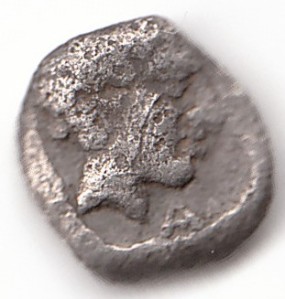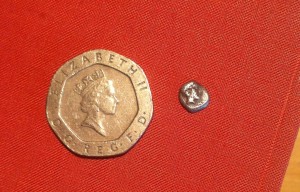Actually my rarest coin is a Tetartemorion, which took me quite a couple of rainy weekends of research to get identified.
The obverse of the tiny coin bears a head of an animal, which is described in the literature as the head of a boar. To be honest, for a boar I am missing the tusks. The similiarity with boars on coins of the same time, even from the same region, like Euromos (see below) is limited. Any suggestions what kind of animal the stamp cutter had in mind? Might this be a wolf? Howbeit the snout looks piggish anyway..…..
….
.
Although parts of the coin are covered by a dark film of horn silver, the sea dweller on the revers is determined easily as a prawn or shrimp. As Iasos was famous for its seafood, especially for its big prawns in ancient times it is not suprising that the city authorities decided to put this merchandise on the coins. Noteworthy enough, as there is only one other Polis in Asia Minor bearing the prawn on its coinage, the town of Priapos in Mysia.
This fraction can be ascribed to Iasos with confidence as there are to very similiar coin, Tetartemoria too, bearing the ehnic ΙΑΣ for Iasos (published by K. Konuk, see below). As usual for late fifth century B.C. coins of northern Caria, the Tetartemoria were struck in the reduced milesian weight standard. According to Konuk, this coin is the fifth know Tetartemorion from Iasos, even the third known without inscription – even though I’d rather hold an inscripted one…
Referring to the just mentioned boar, here is a picture of a hemiobol from Iasos neighbouring city of Euromos. Bearing the head of Zeus on the front side, the revers shows a protome (the foreparte of an animal) of a boar, the stiff-bristled crest is clearly visible. The boar is joined by another pig, pictured on a ca. 450 B.C. hemiobol form Kyzikos in Mysia. If the iconographic programme on this Tetartemorions obvers referrs to the civic issues of Euromos – and there is some evidence for this assumption – this would characterize both cities as tied together somehow. If the boar on the Euromos coins is related with Zeus, who is depicted on the obverse, this animal could be an attribute of this God. The local surname of Zeus at Euromos was Lepsynos, a pre-greek name which cannot be translated satisfyingly yet.
For further informartion about the coinage of Iasos see http://cnrs.academia.edu/KorayKonuk/Papers/363799/The_Payment_of_the_Ekklesiastikon_at_Iasos_in_Light_of_New_Evidence





